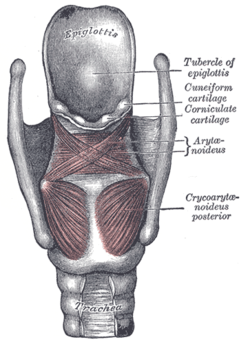Transverse arytenoid
| Transverse arytenoid | |
|---|---|
 Transverse arytenoid is readily seen but not labeled (it is indicated by the lower line of "Arytaenoideus" label) | |
| Anatomical terms of muscle |
The transverse arytenoid is an unpaired intrinsic muscle of the larynx. It is situated deep to the two oblique arytenoids; the oblique and transverse arytenoids are often considered two parts of a single muscle - the interarytenoid (arytenoid) muscle (which is then said to have an oblique part and a transverse part).[1]
The transverse arytenoid bridges the gap between the two arytenoid cartilage in the larynx, occupying the concavity of the lateral surface of each cartilage.[1]
Anatomy
Attachments
The muscle attaches to both arytenoid cartilages, attaching onto each cartilage at the posterior aspect of its muscular process and the adjacent lateral border of the cartilage.[1]
Innervation
The muscle receives motor innervation from the two recurrent laryngeal nerves (each being a branch of the ipsilateral vagus nerve (CN X)); the muscle also receives branches from the internal laryngeal branch, though the latter's contribution to the muscle's motor innervation is unclear.[1]
Function
The muscle approximates the two arytenoid cartilages to close the posterior (intercartilaginous) part of rima glottidis.[1]
References
- ^ a b c d e Standring, Susan (2020). Gray's Anatomy: The Anatomical Basis of Clinical Practice (42th ed.). New York. p. 727. ISBN 978-0-7020-7707-4. OCLC 1201341621.
{{cite book}}: CS1 maint: location missing publisher (link)